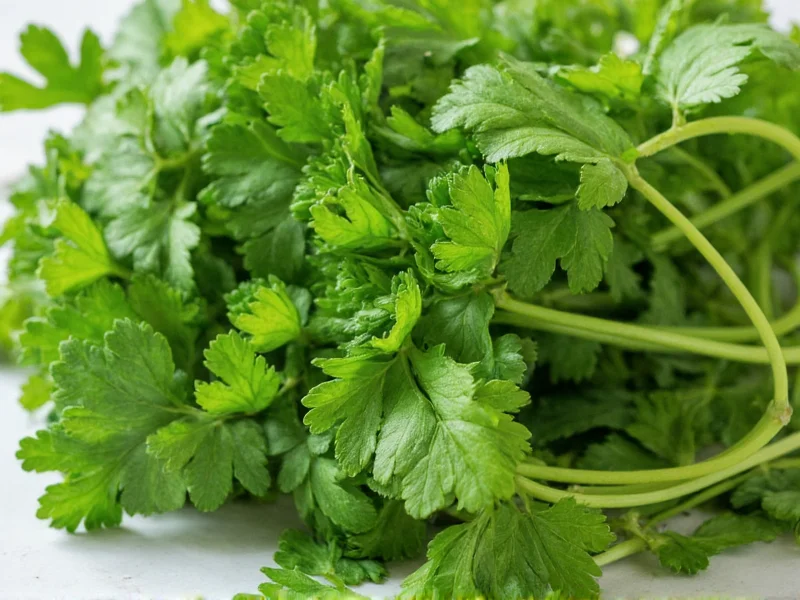The standard conversion ratio for parsley fresh to dried is 1 tablespoon of fresh parsley equals 1 teaspoon of dried parsley. This 3:1 ratio accounts for the moisture loss during drying, which concentrates the flavor. Properly dried parsley retains most of its essential oils when dried slowly at low temperatures (95-115°F) and stored in airtight containers away from light, maintaining optimal flavor for 6-12 months.
Understanding the Parsley Fresh to Dried Conversion
When converting fresh parsley to dried form, the key factor is moisture content. Fresh parsley contains approximately 85-90% water, which evaporates during the drying process. This concentration effect explains why you need three times more fresh parsley by volume to achieve the same flavor impact as dried.
The precise fresh parsley to dried conversion ratio matters significantly in recipe development. Using improper measurements can result in dishes that are either under-seasoned or overpoweringly herbal. Professional chefs consistently follow the 3:1 rule: for every teaspoon of dried parsley required, use one tablespoon of fresh chopped parsley.
Drying Methods Compared for Optimal Flavor Preservation
Several effective techniques exist for transforming fresh parsley into its dried counterpart, each with distinct advantages:
| Drying Method | Time Required | Temperature | Flavor Retention | Best For |
|---|---|---|---|---|
| Air Drying (bunch method) | 1-2 weeks | Room temperature | ★★★☆☆ | Large quantities, traditional approach |
| Oven Drying | 2-4 hours | 150-170°F (65-75°C) | ★★★☆☆ | Quick preservation, small batches |
| Food Dehydrator | 4-6 hours | 95-115°F (35-45°C) | ★★★★☆ | Consistent results, best flavor preservation |
| Freeze Drying | 24-48 hours | Sub-zero temperatures | ★★★★★ | Long-term storage, maximum nutrient retention |
Step-by-Step Guide to Drying Fresh Parsley
Follow these professional techniques to achieve the best dried parsley equivalent to fresh results:
Preparation Process
- Wash fresh parsley thoroughly in cool water to remove dirt and debris
- Gently shake off excess moisture and pat dry with clean kitchen towels
- Remove thick stems but keep smaller leafy stems intact for better drying
- Spread in a single layer on clean towels and air-dry for 1-2 hours before processing
Drying Techniques
For air drying: Bundle 5-6 sprigs together with twine and hang upside down in a dark, well-ventilated area with temperatures between 60-80°F (15-27°C). Complete drying typically takes 10-14 days.
For oven drying: Place prepared parsley on a baking sheet lined with parchment paper. Set oven to its lowest temperature setting (ideally 150-170°F/65-75°C) with the door slightly ajar. Check every 30 minutes until completely dry and crumbly (usually 2-4 hours).
For dehydrator method: Arrange parsley in a single layer on dehydrator trays. Set temperature to 95-115°F (35-45°C) and dry for 4-6 hours, checking periodically. This method provides the most consistent results for fresh vs dried parsley substitution in recipes.
Proper Storage for Maximum Shelf Life
After drying, proper storage determines how long your parsley maintains its flavor. Follow these guidelines for optimal results:
- Cool completely before storing (any residual warmth creates moisture)
- Crumble leaves from stems into airtight glass containers or vacuum-sealed bags
- Store in a cool, dark place away from heat sources and direct sunlight
- Include a silica gel packet to absorb any residual moisture
- Label containers with the drying date for freshness tracking
Well-preserved dried parsley maintains peak flavor for 6-12 months. After one year, while still safe to consume, the herb gradually loses its aromatic compounds and essential oils, resulting in diminished flavor impact when used as a dried parsley equivalent to fresh in recipes.
Cooking Applications: When to Use Each Form
Understanding the flavor profile differences between fresh and dried parsley helps determine the best application:
Fresh parsley excels in:
- Finishing dishes (garnishes, last-minute additions)
- Raw preparations like tabbouleh, chimichurri, or pesto
- Cold dishes where dried herbs won't properly rehydrate
- Dishes requiring bright, grassy notes
Dried parsley works best for:
- Long-cooking dishes (stews, soups, braises) where it has time to rehydrate
- Dry rubs and spice blends
- Sauces that will be cooked further
- Situations requiring extended shelf stability
When substituting dried for fresh in recipes, remember that dried parsley benefits from being added earlier in the cooking process to allow proper rehydration and flavor dispersion. For the most accurate fresh parsley to dried conversion ratio, always measure dried herbs by volume after they've been properly crumbled but before packing them into measuring spoons.
Common Mistakes to Avoid
Many home cooks encounter issues when working with dried parsley due to these common errors:
- Incorrect measurement: Scooping dried parsley directly from storage without proper crumbling leads to inaccurate measurements
- Over-drying: Excessive heat destroys volatile oils, resulting in flavorless, browned parsley
- Poor storage: Exposure to light, heat, or humidity accelerates flavor degradation
- Improper substitution: Using equal volumes instead of following the 3:1 fresh vs dried parsley substitution ratio
- Adding too late: Incorporating dried parsley at the end of cooking when it needs time to rehydrate
For the most accurate results when converting recipes, consider the dish's cooking time and method. In quick-cooking dishes, you may need to increase the dried parsley quantity slightly (up to 25%) since it has less time to rehydrate and release its flavors compared to long-simmering recipes.











 浙公网安备
33010002000092号
浙公网安备
33010002000092号 浙B2-20120091-4
浙B2-20120091-4